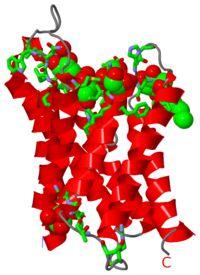Aquaporin 4
From Proteopedia
| |||||||||
| Human Aquaporin 4 complex with glycerol and β-octylglucoside, 3gd8 | |||||||||
|---|---|---|---|---|---|---|---|---|---|
| Ligands: | , | ||||||||
| Gene: | AQP4 (Homo sapiens) | ||||||||
| |||||||||
| |||||||||
| Resources: | FirstGlance, OCA, RCSB, PDBsum | ||||||||
| Coordinates: | save as pdb, mmCIF, xml | ||||||||

Aquaporin 4 (AQP4) is part of the Aquaporin family of channel producing proteins and is the most abundant of the of three water channels in the Central Nervous System (CNS). Its expression is highly upregulated in the astrocytes of the brain cortex and spinal cord [5]. AQP4 allows only water to pass through the channel, preventing the transport of any solute [4]. It also plays a role in the removal of “excess brain water in vasogenic brain edema and hydrocephalus” by an unknown mechanism of bulk excretion of water [2]. However, AQP4 “provides a major route for water entry into the brain through an intact blood–brain barrier” [2], which exacerbates cytotoxic brain edema [2]. In addition, due to AQP4’s short extracellular loop formed from a 310 helix, AQP4 is able to play a role in cell adhesion by interacting with other AQP4 molecules on adjacent cell membranes. Finally, AQP4 plays a role in cell migration. For example, glial-scarring was reduced in the brain following injury due to AQP4-facilitated migration [9], and a role in brain tumor metastases is hypothesized because of AQP4’s elevated expression in glioblastomas and the role of AQP proteins in tumor cell migration [10].
Higher Order Structure of AQP4
AQP4 is organized in the plasma membrane into structures called orthogonal arrays of particles (OAPs). These structures are comprised of both the M23 and M1 isoforms of AQP4, though M23 is specifically required for the formation of OAPs as the amino acid sequence of the N-terminus of the M1 isoform appears to prevent formation of OAPs [4]. The recognition of AQP4’s role in the formation and structure of OAPs has led to further understanding in several neuromuscular diseases, including Duchenne Muscular Dystrophy, and NMO (see “Role in Autoimmune Disorders” below). There is also evidence that the formation of OAPs is physiologically regulated [5].
Role in Autoimmune Disorder
Clinical presentations of central nervous system (CNS) aquaporin-4 autoimmunity are consistent with neuromyelitis optica (NMO), and can include blindness and paraplegia. Previously, variants of the NMO phenotype were classified as differential presentations of Multiple Sclerosis (MS). The specific causes of CNS AQP4 autoimmunity are unknown. However, observations of two patients with brain metastases suggest that CNS AQP4 autoimmunity may develop as part of an immune response to cancer [7]. As is the case in many autoimmune disorders, treatment of CNS AQP4 autoimmunity with anti-inflammatories (such as corticosteroids) and antibody-depleting therapeutics (such as plasma exchange) have been effective at reducing symptoms. Therapies for NMO based on the role of CNS AQP4 autoimmunity await further experimentation of the disease model and cell culture systems. [8]
References
1. Crane, J.M., Tajima, M., and Verkman, A.S. Live-cell imaging of aquaporin-4 diffusion and interactions in orthogonal arrays of particles. Neuroscience (2010) vol. 168 (4) pp. 892-902
2. Hiroaki, Y., Tani, K., Kamegawa, A., Gyobu, N., Nishikawa, K., Suzuki, H., Walz, T., Sasaki, S., Mitsuoka, Kimura, K., Mizoguchi, A., and Fujiyoshi, Y. Implications of the aquaporin-4 structure on array formation and cell adhesion. J Mol Biol (2006) vol. 355 (4) pp. 628-39
3. Nicchia, G.P., Rossi, A., Mola, M.G., Pisani, F., Stigliano, C., Basco, D., Mastrototaro, M., Svelto, M., and A. Frigeri. Higher order structure of aquaporin-4. Neuroscience (2010) vol. 168 (4) pp. 903-14
4. Pittock SJ, and Lennon V.A. Aquaporin-4 autoantibodies in a paraneoplastic context. Arch Neurol (2008) 65:629–632.
5. Hinson, S.R., McKeon, A., and Lennon V.A. Neurological autoimmunity targeting aquaporin-4. Neuroscience (2010) vol. 168 (4) pp. 1009-18.
6. Saadoun S., Papadopoulos M.C., Hara-Chikuma M, Verkman A.S. Impairment of angiogenesis and cell migration by targeted aquaporin-1 gene disruption. Nature (2005) 434:786–792.
7. Verkman A.S., Hara-Chikuma M., Papadopoulos M.C. Aquaporins—new players in cancer biology. J Mol Med (2008) 86:523–529.

